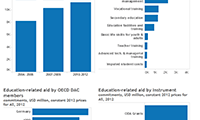Development
Aid to the Water and Sanitation sector
|
The OECD Development Assistance Committee (DAC) collects aid flows at activity level based on a standard methodology and agreed definitions. The Aid to Water Supply and Sanitation sector is broken down into eleven sub sectors including policy, sanitation, supply, rivers and waste.
|
See the data |
||||||||
Water-related aid at a glance (including other official flows)
|
Tables and charts
Online database
|
|||||||
|
General database access: International Development Statistics Online |
||||||||
Read the reports |
|
Related reporting codes and descriptions |
||
| CODES | DESCRIPTION | Clarifications / Additional notes on coverage |
| DAC 5 / CRS | ||
| 140 | WATER AND SANITATION | |
|
14010 |
Water sector policy and administrative management |
Water sector policy and governance, including legislation, regulation, planning and management as well as transboundary management of water; institutional capacity development; activities supporting the Integrated Water Resource Management approach (IWRM: see box below). |
|
14015 |
Water resources conservation (including data collection) |
Collection and usage of quantitative and qualitative data on water resources; creation and sharing of water knowledge; conservation and rehabilitation of inland surface waters (rivers, lakes etc.), ground water and coastal waters; prevention of water contamination. |
|
14020 |
Water supply and sanitation - large systems |
Programmes where components according to 14021 and 14022 cannot be identified. When components are known, they should individually be reported under their respective purpose codes: water supply [14021], sanitation [14022], and hygiene [12261]. |
|
14021 |
Water supply - large systems |
Potable water treatment plants; intake works; storage; water supply pumping stations; large scale transmission / conveyance and distribution systems. |
|
14022 |
Sanitation - large systems |
Large scale sewerage including trunk sewers and sewage pumping stations; domestic and industrial waste water treatment plants. |
|
14030 |
Basic drinking water supply and basic sanitation |
Programmes where components according to 14031 and 14032 cannot be identified. When components are known, they should individually be reported under their respective purpose codes: water supply [14031], sanitation [14032], and hygiene [12261]. |
|
1403 |
Basic drinking water supply |
Rural water supply schemes using handpumps, spring catchments, gravity-fed systems, rainwater collection and fog harvesting, storage tanks, small distribution systems typically with shared connections/points of use. Urban schemes using handpumps and local neighbourhood networks including those with shared connections. |
|
14032 |
Basic sanitation |
Latrines, on-site disposal and alternative sanitation systems, including the promotion of household and community investments in the construction of these facilities. (Use code 12261 for activities promoting improved personal hygiene practices.) |
|
14040 |
River basins’ development |
Infrastructure focused integrated river basin projects and related institutional activities; river flow control; dams and reservoirs [excluding dams primarily for irrigation (31140) and hydropower (23065) and activities related to river transport (21040)]. |
|
14050 |
Waste management / disposal |
Municipal and industrial solid waste management, including hazardous and toxic waste; collection, disposal and treatment; landfill areas; composting and reuse. |
|
14081 |
Education and training in water supply and sanitation |
Education and training for sector professionals and service providers. |
Notes:
1. To assist in distinguishing between “basic” and “large systems” for “water supply” and “sanitation”, consider the number of people to be served and the per capita cost of provision of services.
- Large systems provide water and sanitation to a community through a network to which individual households are connected. Basic systems are generally shared between several households.
- Water supply and sanitation in urban areas usually necessitates a network installation. To classify such projects consider the per capita cost of services. The per capita cost of water supply and sanitation through large systems is several times higher than that of basic services.
2. Integrated Water Resources Management (IWRM) is defined as “a process which promotes the coordinated development and management of water, land and related resources in order to maximise the resultant economic and social welfare in an equitable manner without compromising the sustainability of vital eco-systems”.
Recognising that sectoral approaches to water management tend to impose unsustainably high economic, social and ecological costs, IWRM emphasises decision making across sectors and scales.
Related Documents
- [ TO BE DELETED ]
- Development finance data
- Development finance topics